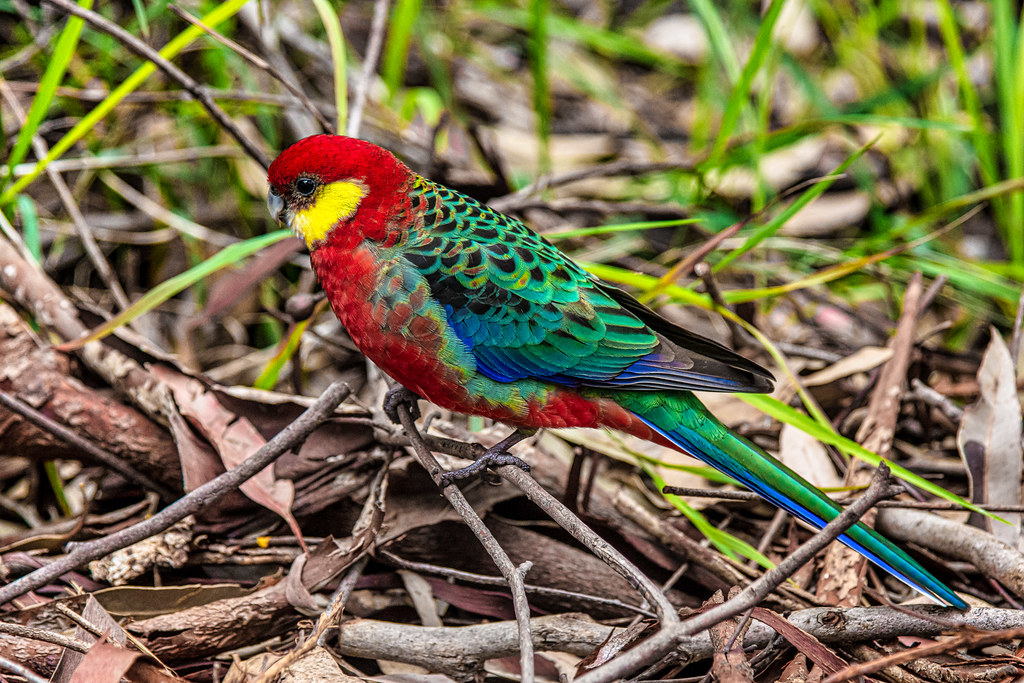Western Rosella (Platycercus icterotis) or moyadong is a quiet and unobtrusive bird in contrast to most other Rosellas. This parrot is often overlooked as it shelters from the heat of the sun amid the leaves of a tree, or moves about on shaded ground searching for seeds.
Western Rosellas measure 255-260 mm in length, including a long attenuate rounded tail. Hence, it is also much smaller than other rosellas. This is also known as Stanley Rosella, Yellow-cheeked Rosella.
The females are distinctly duller than the males, with mottled green and redheads and underparts. During the non-breeding season, they rarely congregate in flocks. Therefore family groups may come together to take advantage of a reliable source of food, such as a heavily laden fruit tree or a spilled bag of wheat.
After crops have been harvested, pairs or family parties of Western Rosellas move over the stubble, picking up fallen grain. On the ground, they walk quickly and easily. They also feed in the tree tops, but less often than other rosellas.

Their diet is varied and includes the seeds of grasses and · other plants, berries, nuts, blossoms, nectar, and insects and their larvae. Western Rosellas have a buoyant, fluttering flight, unlike the heavy, undulating flight of other rosellas.
They usually fly short distances, from one tree to another, rather than over open expanses of land. Like other rosellas, they rest and roost in trees and display there, squareing their shoulders, shaking their spread tails, and whistling softly. Pairing is permanent.
The male feeds his mate several times in the morning and again in the afternoon while she is brooding. They feed each other from time to time without breeding.
MALE: head and entire underparts are red with yellow cheeks. Backs and shoulders have black feathers, which are outlined with green or a mixture of green and red feathers. The rump and upper tail are green or olive-green, sometimes edged with red. The flight feathers and underwing coverts are dusky blue. Central tail feathers are bronze-green washed with blue, and outer tail feathers are blue-edged with white. Eyes are brown and the bill is pale grey, and the cere is dark grey. Their feet and toes are dark gray.
FEMALE: Head and upper breast green with faint yellow and red markings. The frontal band is red with dull yellow cheeks on the back and the wing feathers have dull black centers. An off-white stripe is persistent on the underwing. The lower breast, belly, and vent are light red, strongly suffused with green.

IMMATURES: Like adults, but lack most of the red on the underparts and yellow cheeks. The head is green with a red frontal band. An off-white underwing stripe is present. Young birds gain adult plumage rapidly at about 13-14 months. The downy young are white-downed.
The western rosella contact call in flight is soft and musical-a series of two-note whistles in quick succession.
The nesting and breeding seasons last from August to December. The parrot builds a nest in a hole or hollow in a Eucalyptus tree.
White, rounded eggs measuring 26-27 x 21-22 mm are laid on wood dust at a rate of 3 to 7 (normally 5).
Incubation lasts 18-20 days for females and about 5 weeks for the young to fledge.
As far as distribution is concerned, Western Rosella is common in most types of timbered countries in southwestern Australia, north to Moora and east to Dundas.
Read More – Crimson Rosella Life Spans, Call, and More






